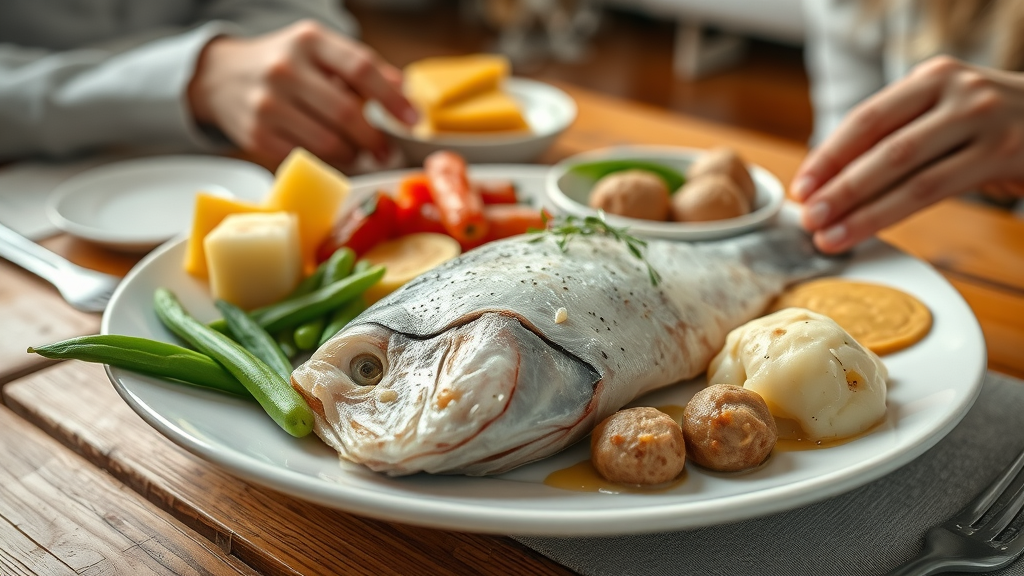Have you ever wondered why, year after year, families across Minnesota gather in winter to serve up a legendary—and often polarizing—Scandinavian delicacy? Minnesota lutefisk traditions may raise eyebrows, but they’re a flavorful thread that stitches generations together, keeping history alive one plate at a time.

Opening Thoughts: Why Do Minnesota Lutefisk Traditions Endure?
Minnesota lutefisk traditions are more than just about eating lutefisk; they represent the heart of a community’s identity and the steadfast celebration of its roots. Even as tastes and food trends evolve, many Minnesotans make room every holiday season for a meal whose origins span centuries and continents.
Lutefisk dinners bring people together—young and old, dedicated lutefisk lovers and first-time tasters alike—fostering a shared experience that stretches far beyond the plate. The act of preparing and sharing this distinctively prepared dried and soaked whitefish invokes memories and stories from generations past, honoring an enduring Christmas tradition. For communities from Minneapolis to small towns like Madison—the proud “lutefisk capital of the United States”—these gatherings are less about the flavor itself, and more about reinforcing the bonds that make Minnesota unique in the upper Midwest.
Minnesota Lutefisk Traditions as a Cultural Bridge
The ritual of eating lutefisk in Minnesota is a living heritage. Children watch their grandparents prepare trays of fish soaked in water and lye, then giggle as stories about “the first lutefisk dinner” are passed around the table. Lutheran church basements, local lodges, and fairgrounds host annual events where new friendships are cemented over steaming plates and side dishes like lefse and green peas. In a state where winter can feel long and isolating, these traditions offer much-needed warmth and community spirit.
"Lutefisk connects Minnesotans to their roots and brings generations together every winter."
What You'll Learn About Minnesota Lutefisk Traditions
- The origins and evolution of Minnesota lutefisk traditions
- Key community events such as lutefisk dinners and festivals
- Historical context: which immigrant group brought lutefisk to the Midwest
- Common side dishes and how they complement eating lutefisk
- Personal perspectives on this enduring Christmas tradition
A Deep Dive into Lutefisk Tradition: Roots and Historical Context
Scandinavian Immigrants and the Birth of the Minnesota Lutefisk Tradition
The story of Minnesota lutefisk traditions begins years ago when Scandinavian immigrants, primarily Norwegians, journeyed to the upper Midwest seeking new opportunities. These pioneers brought with them not only their families but also their culinary customs. As they settled in communities from St. Paul to rural outposts, they recreated familiar dishes that had sustained their ancestors during harsh Nordic winters—none more iconic than lutefisk.
Traditionally, lutefisk began as dried fish, preserved with lye and soaked in water to rehydrate—a vital method for preserving food long before the era of refrigerators. Minnesota’s cold winters and growing Lutheran church influence provided the perfect environment for these customs to thrive. Today, companies like the Olsen Fish Company carry on this legacy, distributing thousands of pounds of lutefisk annually, perpetuating the recipes and rituals introduced by those early settlers.

"Without the arrival of Nordic settlers, the Minnesota lutefisk tradition would simply not exist."
From Christmas Tradition to Statewide Ritual
What began as a distinctly Norwegian Christmas tradition evolved into a multicultural Minnesota ritual. As more families embraced lutefisk, it became woven into the fabric of the holiday season and local celebrations. Today, lutefisk dinners are not just for December 24th—they’re hosted at annual lutefisk nights throughout the winter, featuring everything from folk music to Nordic crafts. High school gymnasiums, small-town churches, and even state fair booths keep the tradition vibrant and visible.
Historical accounts, including those traced by early chroniclers like Olaus Magnus, document the importance of such preserved fish in sustaining families through long winters. Through centuries-old continuity and adaptation, Minnesota has transformed lutefisk tradition from an immigrant survival food into an anticipated event, generating pride and uniting people from all walks of life.
The Social Experience: Lutefisk Dinners and Community
A Minnesota State Fair Staple: Lutefisk at the Heart of Local Festivities
One of the most public (and sometimes playful) demonstrations of Minnesota lutefisk traditions unfolds at the Minnesota State Fair. Each year, guests flock to exhibits and food stands eager for a taste of history. Boasting performances, hands-on demonstrations, and cooking competitions, these events offer newcomers and stalwart fans the chance to discover (or debate) the best way to eat lutefisk.
From the Olsen Fish Company to smaller specialty vendors, the fair transforms lutefisk into a headline attraction, offering plates loaded with classic side dishes: mashed potatoes, green peas, melted butter, and lefse. The fair’s jovial, energetic spirit transforms the polarizing fish dish into a conversation starter, proving that food traditions don’t just endure—they evolve to entertain.
Watch: Lutefisk Preparation and Serving at Minnesota State Fair
Churches, Lodges, and Annual Lutefisk Dinners
While large public events shine a bright spotlight, the heart of the Minnesota lutefisk tradition beats in smaller venues—lutheran church basements, Masonic lodges, and local community halls. Winter calendars fill with fundraisers, socials, and Friday night gatherings, often planned months in advance by dedicated volunteers. Here, the ritual is as much about the preparation as the meal itself: women rolling lefse, grandpas perfecting white sauce, and everyone lending a hand.
Each lutefisk dinner is both simple and spectacular—steaming trays of the gelatinous fish surrounded by a parade of side dishes, endless coffee, and homemade desserts. These events are cross-generational, bringing together grandparents, parents, and children to share stories, laughter, and family pride in a tradition kept alive by collective memory and warm hospitality.
Side Dishes: The Unsung Heroes of Eating Lutefisk
No Minnesota lutefisk tradition would be complete without its cast of culinary co-stars. Side dishes offer familiarity and comfort for those unsure about their first spoonful of fish. Staples include lefse and butter, boiled potatoes, green peas, mustard sauce, and swedish meatballs. Each is more than a distraction—they’re designed to complement and balance the unique texture and flavor of the main dish.
The ritual of loading up on sides unites all guests, regardless of whether they are lifelong lutefisk lovers or hesitant first-timers. Cooks often have strong opinions about whether to use white sauce, melted butter, or mustard sauce—and which combination best honors the tradition. As eating lutefisk continues to generate conversation, side dishes offer a bridge for those curious but not quite ready to dive in head-first.

- Lefse and butter
- Boiled potatoes
- Green peas
- Mustard sauce
- Swedish meatballs
| Side Dish | Classic Pairing | Flavor Profile |
|---|---|---|
| Lefse and butter | Minnesota staple | Soft, mild, slightly sweet |
| Boiled potatoes | Traditional Scandinavian | Earthy and comforting |
| Green peas | Popular at community dinners | Fresh, sweet, colorful |
| Mustard sauce | Common alternative | Tangy, spicy, bright |
| Swedish meatballs | Modern favorite | Savory, rich, hearty |
Modern Adaptations: Minnesota Lutefisk Traditions in the 21st Century
Changing Tastes: Who Eats Lutefisk Now?
In the 21st century, Minnesota lutefisk traditions have faced transformations, as younger generations and newcomers question whether the tradition will last. Yet, recent years have shown a surprising revival: food bloggers, Twin Cities chefs, and community leaders have rekindled curiosity through creative adaptations and themed events. College campuses—even St. Olaf College, with a rich Norwegian heritage—host quirky “first time eating lutefisk” dinners, inviting skeptical students to take part in the adventure.
While some modern palates may balk at the notion of lye-soaked fish with a bold aroma, others cherish the collective experience and opportunity to try something distinctively Minnesotan. In a multicultural and ever-evolving food scene, lutefisk remains an invitation to connect, discover, and honor where Minnesota’s communities came from—and where they’re headed.

Lutefisk Capital of the United States: Small Town Pride in Minnesota State
No discussion of Minnesota lutefisk traditions is complete without mentioning Madison, Minnesota—proudly proclaimed as the “lutefisk capital of the United States.” This charming town embodies small-town pride, with annual festivals, vibrant banners, and an ever-growing reputation for serving up thousands of pounds of lutefisk each year. Festivities attract longtime residents, travelers, and even international visitors eager to take part in a slice of living heritage.
Events often spill over into neighboring towns, with local businesses, churches, and high school bands collaborating to celebrate Minnesota’s unique connection to the dish. These seasonal spectacles aren’t just about the food—they’re about forging community resilience, showcasing local talent, and spending quality time in the warmth of tradition, even as frost coats the ground outside.

Personal Reflection: Why I Value Minnesota Lutefisk Traditions
Speaking as someone who grew up with Minnesota lutefisk traditions, I’ve seen how these rituals shape both identity and memory. For my family, eating lutefisk at Christmas dinner isn’t about loving the dish unconditionally—it’s about sharing laughter over stories from years ago, honoring those who set the table before us, and making new memories to pass down.
These traditions remind us that food is more than sustenance; it’s a bridge across generations and cultures. Whether you’re a devout lutefisk lover or a reluctant participant, gathering around the table each year becomes an act of gratitude and togetherness—a gift that travels well beyond the plate.
"Eating lutefisk each Christmas is more about family stories than fish itself."
People Also Ask: Frequently Queried Topics About Minnesota Lutefisk Traditions
Why do Minnesotans eat lutefisk?
Answer: Minnesotan communities eat lutefisk to honor their Scandinavian heritage, maintain family traditions, and as a celebration of togetherness during the Christmas season.
What is the tradition of lutefisk?
Answer: The lutefisk tradition combines the preparation and communal consumption of lye-soaked whitefish, tracing its roots to Nordic immigrants who viewed it as a staple for winter gatherings and Christmas celebrations.
Where is the lutefisk capital of the United States?
Answer: Many recognize Madison, Minnesota as the 'lutefisk capital' due to its large annual lutefisk servings and Nordic festivities.
Which immigrant group brought the tradition of preparing lutefisk to the Midwest?
Answer: Scandinavian immigrants, specifically Norwegians, introduced the lutefisk tradition to the Midwest, which became integral to Minnesota's cultural tapestry.
Frequently Asked Questions about Minnesota Lutefisk Traditions
How is lutefisk prepared and served at Minnesota gatherings?

Lutefisk preparation is a labor of love that begins weeks before the meal. The whitefish is first dried, then soaked in a lye solution before being rinsed multiple times and finally soaked in water to restore its texture. Cooks then simmer or bake the fish, often using boiling water or a gentle oven heat. The finished lutefisk is served hot, accompanied by a spread of classic sides: boiled potatoes, green peas, lefse with butter, white sauce or melted butter, and sometimes a savory helping of swedish meatballs. The communal act of serving and eating lutefisk is as important as the taste itself, with servers and guests sharing advice, family tales, and plenty of encouragement.
Why is lutefisk especially popular as a Christmas tradition?
Lutefisk’s reputation as a Christmas tradition stems from its role as a centerpiece at holiday meals among Norwegian and Swedish families. Its seasonal preparation and nostalgic connection to winter celebrations make it a comforting, if acquired, staple that signifies the start of the festive period. For many families, lutefisk dinners evoke cherished memories, signaling both reverence for heritage and the joy of gathering despite Minnesota’s snowy, cold climate.
What makes Minnesota lutefisk traditions different from other states?
Minnesota lutefisk traditions stand out due to the scale of their celebration, the involvement of entire communities, and the creative ways in which the legacy endures. The state’s strong Scandinavian roots, annual events like those at the Minnesota State Fair, and the sheer quantity of pounds of lutefisk prepared every year establish Minnesota as the epicenter of lutefisk pride in the United States. Local producers, such as the Olsen Fish Company, further reinforce Minnesota’s leadership by supplying not only their home state but also the wider region with this historic delicacy.
Key Takeaways on Minnesota Lutefisk Traditions
- Minnesota lutefisk traditions are rooted in Scandinavian heritage and maintained by vibrant communities.
- Lutefisk dinners serve as intergenerational gatherings, celebrating history and culture.
- Side dishes and local variations add unique local flavor to the practice.
- Modern adaptations reflect changing tastes but respect traditional values.
Conclusion: The Enduring Relevance of Minnesota Lutefisk Traditions
" Minnesota lutefisk traditions may change with time, but their spirit persists in every shared family meal."
Partner with Minnesota Healthy Living – Inquire about Advertising Opportunities
Want to reach passionate Minnesota audiences who cherish local heritage and traditions? Partner with Minnesota Healthy Living. Inquire about advertising opportunities today → info@minnesotahealthyliving.com
Minnesota’s lutefisk traditions are deeply rooted in Scandinavian heritage, with church halls across the state hosting annual dinners to keep this culinary practice alive. Despite a decline in consumption, these events continue to draw crowds, reflecting a commitment to preserving cultural identity. (apnews.com)
In recent years, some churches have adapted their lutefisk dinners to accommodate changing times. For instance, during the pandemic, the American Swedish Institute in Minneapolis introduced a drive-through lutefisk event, blending tradition with innovation to maintain community engagement. (startribune.com)
Additionally, younger generations are taking initiatives to sustain these traditions. A Minnesota millennial, for example, has been actively involved in organizing and promoting church-sponsored lutefisk dinners, aiming to bridge the gap between older and younger community members. (startribune.com)
These efforts highlight the enduring significance of lutefisk in Minnesota’s cultural landscape, demonstrating how communities adapt to preserve their heritage while embracing contemporary approaches.
 Add Row
Add Row  Add
Add 



Write A Comment